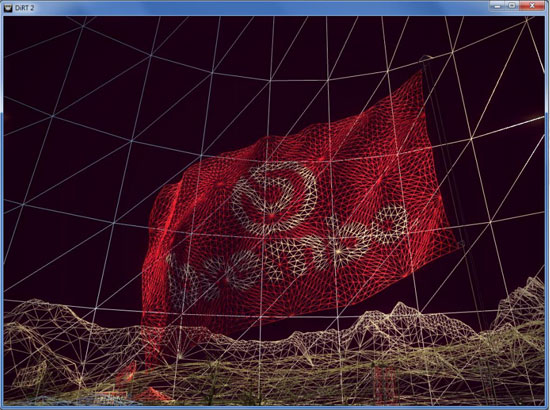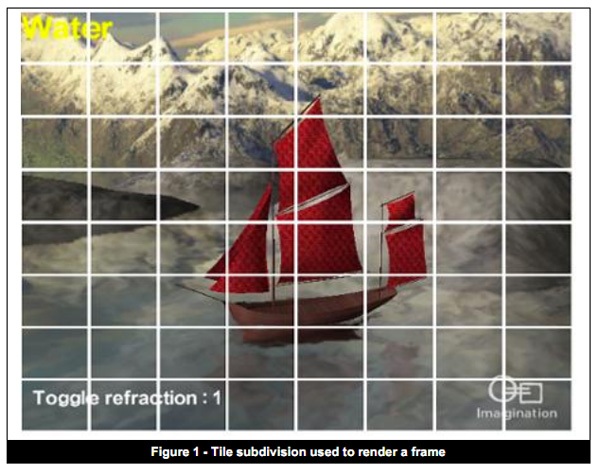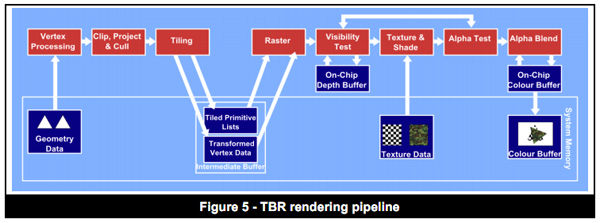Samsung Galaxy S 2 (International) Review - The Best, Redefined
by Brian Klug & Anand Lal Shimpi on September 11, 2011 11:06 AM EST- Posted in
- Smartphones
- Samsung
- Galaxy S II
- Exynos
- Mobile
Understanding Rendering Techniques
It's been years since I've had to describe the differences in rendering techniques but given the hardware we're talking about today it's about time for a quick refresher. Despite the complexities involved in CPU and GPU design, both processors work in a manner that's pretty easy to understand. The GPU fundamentally has one function: to determine the color of each pixel displayed on the screen for a given frame. The input the GPU receives however is very different from a list of pixel coordinates and colors.
A 3D application or game will first provide the GPU with a list of vertex coordinates. Each set includes the coordinates for three vertices in space, these describe the size, shape and position of a triangle. A single frame is composed of hundreds to millions of these triangles. Literally everything you see on screen is composed of triangles:

Having more triangles (polygons) can produce more realistic scenes but it requires a lot more processing on the front end. The trend in 3D gaming has generally been towards higher polygon counts over time.
The GPU's first duty is to take this list of vertices and convert them into triangles on a screen. Doing so results in a picture similar to what we've got above. We're dealing with programmable GPUs now so its possible to run code against these vertexes to describe their interactions or effects on them. An explosion in an earlier frame may have caused the vertices describing a character's elbow to move. The explosion will also impact lighting on our character. There's going to be a set of code that describes how the aforementioned explosion impacts vertices and another snippet of code that describes what vertices it impacts. These code segments run and modify details of the vertices at this stage.

With the geometry defined the GPU's next job is rasterization: figure out what pixels cover each triangle. From this point on the GPU stops dealing in vertices and starts working in pixel coordinates.
Once rasterized, it's time to give these pixels some color. The color of each pixel is determined by the texture that covers that pixel and/or the pixel shader program that runs on that pixel. Similar to vertex shader programs, pixel shader programs describe effects on pixels (e.g. flicker bright orange at interval x to look like fire).
Textures are exactly what they sound like: wallpaper for your polygons. Knowing pixel coordinates the GPU can go out to texture memory, fetch the texture that maps to those pixels and use it to determine the color of each pixel that it covers.
There's a lot of blending and other math that happens at this stage to deal with corner cases where you don't have perfect mapping of textures on polygons, as well as dealing with what happens when you've got translucency in your textures. After you get through all of the math however the GPU has exactly what it wanted in the first place: a color value for every pixel on the screen.
Those color values are written out to a frame buffer in memory and the frame buffer is displayed on the screen. This process continues (hopefully) dozens of times per second in order to deliver a smooth visual experience.
The pipeline I've just described is known as an immediate mode renderer. With a few exceptions, immediate mode renderers were the common architectures implemented in PC GPUs over the past 10+ years. These days pure immediate mode renderers are tough to find though.

IMRs render the full car and the tree, even though part of the car is occluded
Immediate mode renderers (IMRs) brute force the problem of determining what to draw on the screen. They take polygons as they receive them from the CPU, manipulate and shade them. The biggest problem here is although data for every polygon is sent to the GPU, some of those polygons will never be displayed on the screen. A character with thousands of polygons may be mostly hiding behind a pillar, but a traditional immediate mode renderer will still put in all of the work necessary to plot its geometry and shade its pixels, even though they'll never be seen. This is called overdraw. Overdraw unfortunately wastes time, memory bandwidth and power - hardly desirable when you're trying to deliver high performance and long battery life. In the old days of IMRs it wasn't uncommon to hear of 4x overdraw in a given scene (i.e. drawing 4x the number of pixels than are actually visible to the user). Overdraw becomes even more of a problem with scene complexity.
Tile Based Deferred Rendering
On the opposite end of the spectrum we have tile based deferred rendering (TBDR). Immediate mode renderers work in a very straightforward manner. They take vertices, create polygons, transform and light those polygons and finally texture/shade/blend the pixels on them. Tile based deferred renderers take a slightly different approach.

TBDRs subdivide the scene into smaller tiles on the order of a few hundred pixels. Vertex processing and shading continue as normal, but before rasterization the scene is carved up into tiles. This is where the deferred label comes in. Rasterization is deferred until after tiling and texturing/shading is deferred even longer, until after overdraw is eliminated/minimized via hidden surface removal (HSR).
Hidden surface removal is performed long before we ever get to the texturing/shading stage. If the frontmost surface being rendered is opaque, there's absolutely zero overdraw in a TBDR architecture. Everything behind the frontmost opaque surface is discarded by performing a per-pixel depth test once the scene has been tiled. In the event of multiple overlapping translucent surfaces, overdraw is still minimized. Only surfaces above the farthest opaque surface are rendered. HSR is performed one tile at a time, only the geometry needed for a single tile is depth tested to keep the problem manageable.

With all hidden surfaces removed then, and only then, is all texture data fetched and all pixel shader code executed. Rendering (or more precisely texturing and shading) is deferred until after a per-pixel visibility test is passed. No additional work is expended and no memory bandwidth wasted. Only what is visible in the final scene is rasterized, textured and shaded on each tile.
The application doesn't need to worry about the order polygons are sent for rendering when dealing with a TBDR, the hidden surface removal process takes care of everything.
In memory bandwidth constrained environments TBDRs do incredibly well. Furthermore, the efficiencies of a TBDR really shine when running applications and games that are more shader heavy rather than geometry heavy. As a result of the extensive hidden surface removal process, TBDRs tend not to do as well in scenes with lots of complex geometry.
What's In Between Immediate Mode and Deferred Rendering?
These days, particularly in the mobile space, many architectures refer to themselves as "tile based". Unfortunately these terms can have a wide variety of meanings. The tile based deferred rendering architecture I described above really only applies to GPUs designed by Imagination Technologies. Everything else falls into the category of tile based immediate mode renderers, or immediate mode renderers with early-z.
These GPUs look like IMRs but they implement one or both of the following: 1) scene tiling, 2) early z rejection.

Scene tiling is very similar to what I described in the section on TBDRs. Each frame is divided up into tiles and work is done on a per-tile basis at some point in the rendering pipeline. The goal of dividing the scene into tiles is to simplify the problem of rendering and better match the workload to the hardware (e.g. since no GPU is a million execution units wide, you make the workload more manageable for your hardware). Also by working on small tiles caches behave a lot better.
The big feature that this category of GPUs implements is early-z rejection. Instead of waiting until after the texturing/shading stage to determine pixel visibility, these architectures implement a coarse test for visibility earlier in the pipeline.
Each vertex has a depth value and using those values you can design logic to find out what polygons (or parts of polygons) are occluded from view. GPU makers like ATI and NVIDIA introduced these early visibility tests years ago (early-z or hierarchical-z are some names you may have heard). The downside here is that early-z techniques only work if the application submits vertices in a front-to-back order, which does require extra work on the application side. IMRs process polygons in the order they're received, and you can't reject anything if you're not sure if anything will be in front of it. Even if an application packages up vertex data in the best way possible, there are still situations where overdraw will occur.
The good news is you get some of the benefits of a TBDR without running into trouble should geometry complexities increase. The bad news is that a non-TBDR architecture will still likely have higher amounts of overdraw and be less memory bandwidth efficient than a TBDR.
Most modern PC GPUs fall into this category. Both NVIDIA's Fermi and AMD's Cayman GPUs do some amount of tiling although they have their roots in immediate mode rendering.
The Mobile Landscape
Understanding the difference between IMRs, IMRs with early-z, TBRs and TBDRs, where do the current ultra mobile GPUs fall? Imagination Technologies' PowerVR SGX 5xx is technically the only tile based deferred renderer that allows for order independent hidden surface removal.
Qualcomm's Adreno 2xx and ARM's Mali-400 both appear to be tile based immediate mode renderers that implement early-z. This is particularly confusing because ARM lists the Mali-400 as featuring "advanced tile-based deferred rendering and local buffering of intermediate pixel states". The secret is in ARM's optimization documentation that states: "One specific optimization to do for Mali GPUs is to sort objects or triangles into front-to-back order in your application. This reduces overdraw." The front-to-back sort requirement is necessary for most early-z technologies to work properly. These GPUs fundamentally tile the scene but don't perform full order independent hidden surface removal. Some aspects of the traditional rendering pipeline are deferred but not to the same extent as Imagination's design.

NVIDIA's GeForce ULP in the Tegra 2 is an IMR with early-z. NVIDIA has long argued that its design is the best for future games with increasing geometry complexities as a result of its IMR design.
Today there's no real benefit to not building a TBDR in the ultra mobile space. Geometry complexities aren't very high and memory bandwidth does come at a premium. Moving forward however, the trend is likely going to mimic what we saw in the PC space: towards more polygon heavy games. There is one hiccup though: Apple.

In the evolution of the PC graphics industry the installed base of tile based deferred renderers was extremely small. Imagination's technology surfaced in two discrete GPUs: STMicro's Kyro and Kyro II, but neither was enough to stop NVIDIA's momentum at the time. Since immediate mode renderers were the norm, games simply developed around their limitations. AMD and NVIDIA both eventually implemented elements of tiling and early-z rejection, but TBDRs never took off in PCs.
In the ultra mobile space Apple exclusively uses Imagination Technologies GPUs, which I mentioned above are tile based deferred renderers. Apple also happens to be a major player, if not the biggest, in the smartphone/tablet gaming space today. Any game developer looking to put out a successful title is going to make sure it runs well on iOS hardware. Game developers will likely rely on increasing visual quality through pixel shader effects rather than ultra high polygon counts. As long as Imagination Technologies is a significant player in this space, game developers will optimize for TBDRs.










132 Comments
View All Comments
shamalh108 - Monday, September 12, 2011 - link
Thanks alot, going to do that today, however if you read my post above im not sure its an individual app causing it. Maybe i should root so i can wipe the battery stats and recalibrate, besides that im also going to purchase the offical extended battery from samsung, i dont mind losing slight slimness:)ph00ny - Monday, September 12, 2011 - link
I didn't even bother with rooting for a month or two until i wanted to try out chainfire plugins. Even in stock form, battery life was great. certainly better than my captivate.One thing to understand about SAMOLED screen is that it uses 0 power on black pixel and more power on white pixels. So maybe try out a darker themed wall paper and also check to see if you have widgets that have tendency to use up more juice than an alternative
Also for an example, samsung's stock music app uses roughly half of Google's music app power consumption. It gets worse with spotify (offline mode of course)
Remeniz - Monday, September 12, 2011 - link
The trick is to adjust the power saving features to suit and make sure very little is going on in the back ground. I only run GPS if I need too and the WiFi gets turned off when i'm out and about, unless I know i'm in a WiFi zone and want to browse the www.I get at least a days use out of my SGS2.
supercurio - Monday, September 12, 2011 - link
Note:"When idle, processor goes back to 200 MHz"
Idle - screen on or an using a wakelock to keep the device on its the case.
Otherwise the whole CPU is turned literally OFF − everything frozen in RAM.
And in this situation, the baseband, Wi-fi chip or an external timer will wake up the CPU and restore Linux kernel in a working state when needed, like if you received a new mail, or a phone call.
I precise that because most people believe the CPU stays ON all the time but it's the opposite, with standard usage, the CPU is ON only a fraction of the day.
Lucian Armasu - Sunday, September 11, 2011 - link
Brian, I don't think it's fair to compare the "tablet" version of A5 with the "smartphone" version of the Exynos and all the other chips. Even Nvidia's Tegra 2 has either 50% or 100% higher clock frequency for its GPU in the tablets, compared to the one in smartphones.It's very likely that all tablet chips are more powerful than the smartphones ones, and for all we know the iPhone 5 GPU will only one 1 GPU core instead of 2 like in the iPad 2, or they'll be clocked at a lower frequency.
I know you'll review the iPhone 5, too, but I think you're setting a too low expectation for the Exynos and the others compared to the "A5 chip". You know what I mean? You should've at least thrown a Xoom or a Transformer in there to see how it fairs against the Tegra 2 phones.
I hope at least you'll correct this in future reviews. Great review otherwise, though.
privater - Sunday, September 11, 2011 - link
An iPad 2 can run sun spider 0.9 with 1980 score (4.3.5)If the Exynos is superior on every aspect of A5, the result is difficult for me to understand.
Lucian Armasu - Sunday, September 11, 2011 - link
Just as I mentioned above, it's not fair to compare the tablet versions with the phone versions of the chips. All the latest smartphones get around 4000 in the Sun Spider test, but all tablets get around 2000 in that test, so even on the CPU side, it's still not a fair comparison.Mike1111 - Sunday, September 11, 2011 - link
Great review!But why are you so late with the review of the INTERNATIONAL version? I mean I would get it if you decided to wait for the US versions, but waiting almost 4 1/2 months and then publish a review of the international version only a week before the US versions get released? Seems strange to me...
ph00ny - Sunday, September 11, 2011 - link
Brian said in the other reviews comment sections that he was waiting to get ahold of a review unit. I did offer mine if he was nearby but he's nearly on the west coast and i live in the opposite side of the countryshamalh108 - Sunday, September 11, 2011 - link
Another pity is that even games from gameloft which are supposed to be adapted to the SGS2 cause significant heating of the phone.. for example the Asphalt 6 available for free in Samsung Apps .. it would be great if more games were coded to make better use of the SGS2 gpu ...